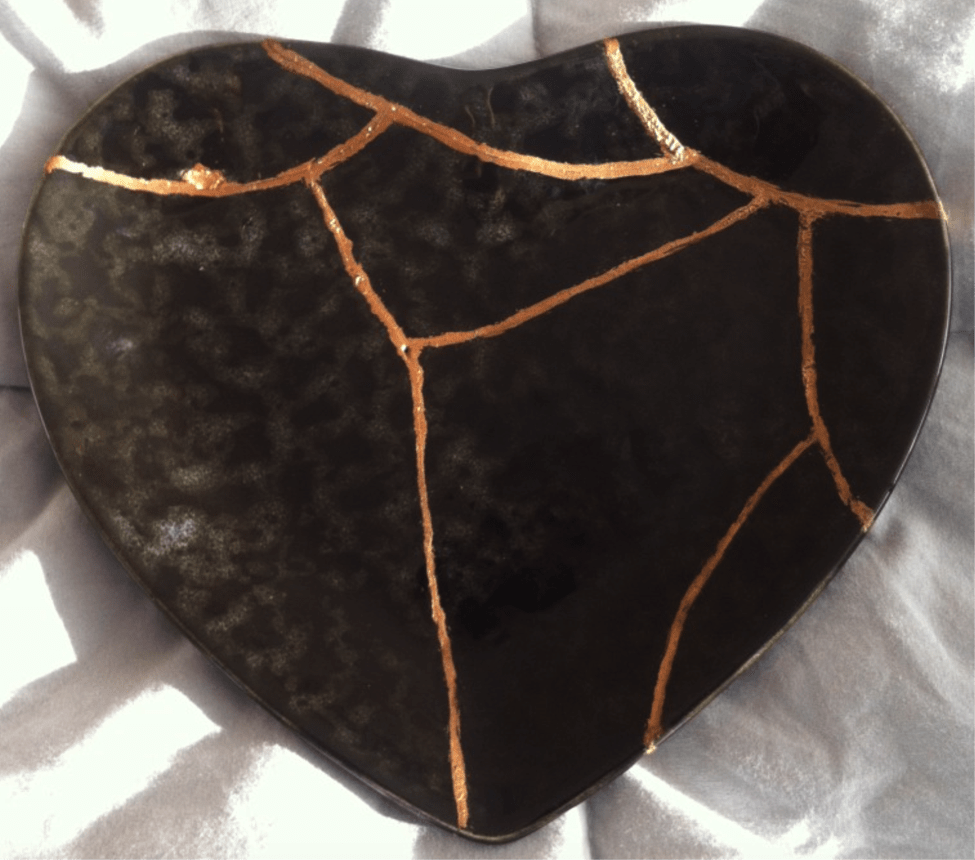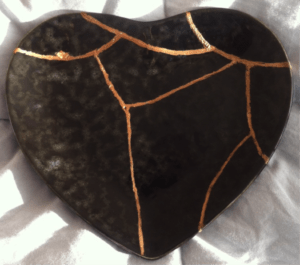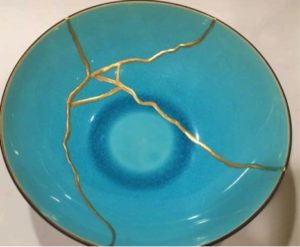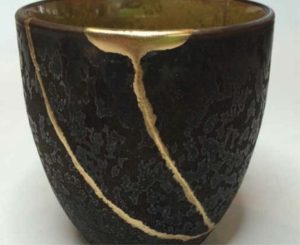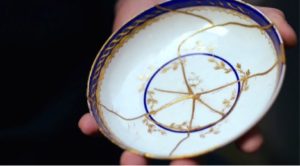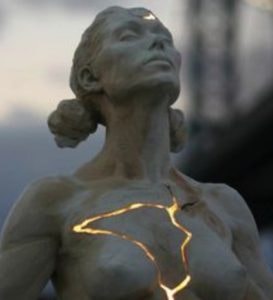When facing my own trauma and brokenness I prided myself on not burdening others with my issues. Hell, after all, I was a trained and experienced ‘container of pain’, and I had to ‘to keep it together’ for everyone else’s sake. This was my role in my family too. Meanwhile, my fractures were deepening; destabilizing and splintering my soul and spirit along the way. I knew inherently and from the experiences of others that pain was a useful emotion, but when I looked at my own pain and trauma and the associated shame, it didn’t feel that way to me. When I gazed into my own soul, I didn’t see potential for growth or strength; something that could become beautiful or strong.
I’ve experienced more trauma and pain then the average person and most people in my personal and professional life have little knowledge of the depth and amount of it. I used to think that was the proper way to handle it. In Part 1 I spoke to how this didn’t serve me. I also examined how looking at all the pain as HORRIBLE was to my detriment too.
And I knew I wouldn’t survive if I didn’t change both of those ways of relating to my pain.
I’m thriving today because of my broken places. I’m no longer ashamed of my stories, of my trauma, of my brokenness. And on most days, I see beauty in my brokenness. Every day I feel the strength within those fractures.
But how?
The process of finding beauty in brokenness started with re-defining the concept of ‘brokenness’ as I explored in Part 1. I had a huge a—ha moment when I was exposed to a few interwoven Japanese concepts that gave me incredible nuggets which spurred a shift in my view of trauma and brokenness. Kintsukuroi is the Japanese art of repairing broken pottery with lacquer mixed with powered gold. The underpinning philosophy is that the process treats breakage or brokenness as an integral part of the history of the piece rather than something to hide or disguise. Further the Japanese philosophy of wabi-sabis, embracing imperfections, solidifies this concept by highlighting the cracks and repairs (healing) as ‘simply an event in the life of an object’. And finally Kintsugi is the concept of emphasizing imperfections and visualizing the mending as an area to celebrate rather than a focus on the loss or missing pieces. It synthesizes loss and brokenness into repair and rebirth.
When I first learned of this concept, I had a visceral reaction that looked a lot like wtf? I went straight to a moment where my son threw a ball in my parents’ living room and smashed several prized figurines. I did not embrace those little shards and when I saw the added glue to the base of the penguin fin, I didn’t celebrate those mended places. I was pissed he had thrown that ball and I felt horrible it broke a prized possession. It felt shameful. Every. Time. I. Saw. It. And this was just a little thing. My parents didn’t actually care much. But I did. At this point in my life, I questioned how any object that is broken be seen as beautiful? I thought that was the very definition of broken.
Until I saw the artwork of Kintsukuroi.
I saw the beauty in it. I loved that the truest form of this art isn’t about purposefully breaking the pieces in order to add the gold but to work with the inevitability of the shattered places and strengthen them. And ultimately, to highlight the beauty of them.
As I wrote yesterday I have personal experience with brokenness. We all do. My current set of fractures may be the most significant in details but it FEELS different than the other traumas in my past. Because my view of it is different. I’ve sat in wonderment of the details, of my internal reaction to it and my outward expression of it. I’ve marveled at the mystery of it. Why is this happening? How did the pieces fall together like this to end in this manner? I’ve sat there in neutral curiosity.
Now, I’ve also sobbed and felt like a victim and felt anger too. There have been times in my recent sadness that I was the Mayor of Victimville and was a HOT FREAKING MESS grasping for support and pleading for mercy. Embracing brokenness doesn’t always look like rainbows and smell of patchouli oil.
But sometimes it does.
Because I’ve also had times of intense grace and peace, of hope and happiness and such love that I was overcome with the magnificence of connection and growth.
And that is often how it is with our personal wounds and traumas. We wear them as badges of pride (“Look what I’VE been through.”) , share as evidence of our martyrdom (“ I just don’t know how this keeps happening to me.”) or slowly and shamefully reveal them with apologies (“You won’t want to be with me, I’m such a mess. RUN!”).
I’ve been all three. And more.
But I stopped that way of interacting with my pain. That viewpoint. It FELT like it served me but it didn’t. I was stuck in those stories. And I was recreating them in my life. Over and over. This was HARD to see. Hard to see my responsibility in some of my traumas and it was harder still to accept that some of my broken places were completely out of my control. It was then I realized that seeing and accepting the certainly of pain in life was the key to finding the strength within the brokenness. Profoundly I understood this.
And suddenly pottery pieces that weren’t broken seemed too perfect. I started looking for the broken places. I began seeing the beauty and the wonderment within them. I saw them in the Kintsukuroi artwork, I saw them within my clients and all around me. Instead of feeling the weight of world’s pain, I saw possibilities of this brokenness strengthening everyone. I could accept the inevitability of each one of our painful journey and I could also see the opportunities for soul deepening, connections growing and wonderment expanding.
Then I was able to see it within myself too. I had an awakening. In my work as a therapist, I needed to build rapport with my clients so they trusted me. I realized, I was having trouble trusting myself.
And when I did that. When I trusted myself, fractures and all, the patterns in my life starting changing. Some of those changes were rough and at first unwanted. It ended a marriage that was very unhealthy for me. It ended friendships that weren’t serving me. And this shift started bringing the best kind of souls into my life. My career took off. My friendships deepened. I was more fully present with my children. I opened to an epic level kind of love. And most importantly, I accepted me for me. I experienced stillness and contentment and joy. Authentically.
Again, don’t get me wrong. This isn’t how I feel 100% of the time. I still get frustrated at my kids and have meltdowns and feel sorry for myself. But those moments are few and far between.
But there is another way.
Here is how you do it:
- Identify how you relate to your pain and trauma.
I find that people fall into one of two categories with how they relate to soul pain. Their brokenness is visible—they are posting on FB, they are actively seeking support and sharing their pain with friends or people in the grocery line, their healing journey is palpable with how they carry themselves and their spirit.
Or their trauma is under wraps. On the outside, things are carrying on in the typical fashion and few people have any clue something has happened or this person is drowning privately and suffering greatly internally.
Of course there is a continuum of this expression and we can bounce back between the two depending on the severity and circumstances but….in general we have a go-to survival expression of trauma and neither is good nor bad. It just is what we’ve learned and works with our personality and surroundings.
- Without judgment, make two lists. The first is how this way of relating to your pain as served you and the second how it has not served you. It is key you do this without judgment. It is important that you really examine both sides of this so that you can own the initial part of your pattern with pain.
Example:Public with my pain
Serves me: I received comforting messages on FB, I feel like it releases my pain from me and writing about it and giving it to others help me process it, I don’t feel isolated, people give me a break that I’m not my typical self because they know what is going on.
Doesn’t serve me:People don’t know what to say sometimes and that makes me feel like I am a terrible person, that is all my friend asks about it and sometimes I want to pretend it isn’t happening, it is keeping me stuck in my story and is the focus on my day.
- Write about your soul pain. What are the deepest parts of your fissures? Don’t be afraid to go there. Write in narrative form or bullet it. See the pain. Make it concrete. How did they manifest in your body? What emotions were brought out because of them. Get it out. Get the ugly, the shitty, the yuck—out. Think of the little, petty things. Explore the things that you did to yourself that hurt you. Gut out the parts of life that happened to you. What is the story that you have written about yourself UP UNTIL THIS POINT. This is about the past. It is about getting out the cracks and crevices but also about acknowledging how you got here, honestly. It sounds like this: Sam cheated on me, my baby died, I got an STD, Sarah betrayed our friendship, I lost three jobs, I hated my college experience, I knew I should have broken up with Kelly but held on because I didn’t want to be alone, I’ve played victim my whole adult life, I’ve always felt different and unwanted, I hate my breast size, my church let me down, my parents’ divorce destroyed my view of love. etc.….go big, go nuance. But go there.
- What are the silver linings in those moments? For each of those things find the good that came of it. There is ALWAYS something good in the yuck. Write about it. Find images for them. Dig deep if you have to. They don’t have to be bright shiny silver things, but EVERY shit experience has something in it that was positive. If you really can’t find something good or you feel like your silver lining is surface….keep that fissure out to keep revisiting. You may need to reflect on it more and you may not be ready to release it. If you can’t find a silver lining to something, you can also go back to the exercise of how it served you and didn’t serve you. Insight may rise from that thought process.
Silver lining Example:
My lover died: I realized how much she meant to me. I realized how much I depended on her for my identity and social life and was able to stand on my own with more certainty after a year’s time. In my next relationship I was more independent.
Sarah was a real bitch of a friend: I learned how I want to be treated. I started speaking my boundaries. I remembered that I treated Leslie like that a few years ago and went to her and apologized.
I lost my job: I learned how to budget better. I ended up meeting Ken at the coffee house when I was writing.
I can’t keep an erection during penetration: I focused my skill of giving oral sex and now I am complimented more than ever and don’t feel like a bad lover.
- Kintsukuroi The Hell Out of It. As you find those beautiful moments, visualize painting them with the gold lacquer of the Kintsukuroi I’m serious. Do this. This is such an important part of the process. It helps cement the mind shift of it.
This isn’t a one-time process. I did this many times. I’d remember things. I’d see I was hanging on to things. New things would happen. The gold lacquer would start fading and I’d hear old ways creeping into my thoughts. So I do tune ups. I don’t judge them. This process isn’t natural to us. We aren’t typically surrounded by people who think like this so we need to do this multiple times. I don’t see that as bad.
I also did things like surround myself with people who did look at the world like this, who shared the strengths of their trauma and pain. I carefully watched my words and worked to weed out things that kept me in the place of being a victim/why me/how could this happen. I forced myself to see the good until I could do it naturally. I went to workshops and read books and listened to music that uplifted me. And I painted with gold.
Every chance I could.
And mostly, I let myself grieve what needed to be grieved, I released what and who didn’t serve me and I fought for my strength until I saw that it was actually what sustained me. For some this is found in spiritual faith, for others it is that and a process like this, for some it is elusive. It is a matter of choice. It requires hard work. And it requires beauty and strength.
And it is worth it. All the risk. All the tears. All the hard work.
I am living proof.
Don’t give up on the beautiful parts. See the beauty in your brokenness. Find the strength in your broken parts.
And paint it all with gold.
Let me know what you think about the golden broken parts. Are you ready to share your journey of healing?
Please join in on the conversation in the comments on my FB page and within the comments on my website. Email me questions and your stories at drjulianamorris@gmail.com . I’ve made this a private email that none of my team members read. I read all of my emails and answer them personally as soon as I can. I love hearing from you.
X oh,
Dr. Juliana

